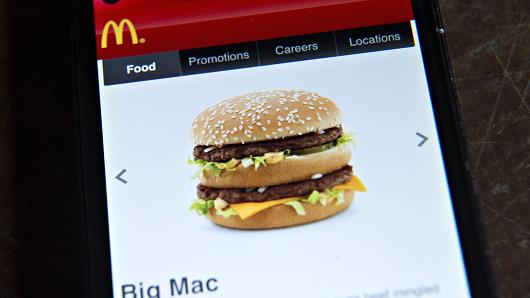Sustainably sourced coffee, $1 dollar Cokes
On fast food giant McDonald’s Corp.’s Twitter feed, videos featuring its sustainably sourced coffee or Alaska pollock for its Filet-O-Fish sandwich are mixed with posts featuring any size Coke for just $1 or its “crispy, golden fries.”
The juxtaposition shows the balancing act the fast food giant must manage, honoring its roots and retaining its core customers while crafting a new image that meets consumers’ increasing preference—millennials in particular—for healthier, natural, environmentally conscious food.
See McDonald’s sales breakdowns, real-estate productivity information and more in eMarketer’s retail and ecommerce database.
So far, the balancing act appears to be paying off: On Tuesday the company reported its seventh straight quarter of positive same-store sales gain without sacrificing profit.
During the company’s earnings call on Tuesday, President and CEO Steve Easterbrook pointed to the company’s move to use more cage-free eggs and sustainable beef, and its recently announced decision to use fresh beef instead of frozen meat for its Quarter Pounder in all US restaurants by mid-2018. He also mentioned a visit he made to a farm in Ireland that McDonald’s is working with to produce sustainable beef.
McDonald’s is on a tightrope. Easterbrook said there’s a “sense of urgency” that the company must act to retain existing customers while regaining lapsed patrons and converting casual customers to regular visitors.
MCDONALD’S PLANS TO EXPAND MOBILE ORDER AND PAY SERVICE TO ALL OF ITS 14,000 US RESTAURANTS BY THE END OF THIS YEAR.
To retain its core customers and fend off competition from fast food rivals including Wendy’s and Burger King, McDonald’s said it “has fought harder on the value side” of its menu the past few months, including such deals as the $1 any size coffee or Coke. Its all-day breakfast menu continues to generate “ongoing customer enthusiasm,” the company said. McDonald’s also is keeping more restaurants open 24/7 in markets like the UK and is planning to expand mobile order and pay service to all of its 14,000 US restaurants by the end of this year.
It’s also testing delivery services in Florida and is renovating more locations to feature its “experience of the future” concept, which includes self-service ordering kiosks that allow patrons to customize their orders and wait at a table for food to be brought to them when their order is ready. McDonald’s said that in UK stores that feature the new concept, average transaction amount and customer counts have risen.
To be sure, despite the improvements and increased customer visits in markets like the UK and Japan, in the US overall visits are down despite a 1.7% gain in Q1 comparable sales. It’s also too early to say whether digital initiatives such as mobile ordering and delivery will drive growth in the US, said Jefferies analyst Andy Barish.
Meanwhile, results released on the same day from a key vendor, Coca-Cola, show the pressures on established food and restaurant companies. Coca-Cola is cutting 1,200 jobs after reporting an 11% decline in Q1 revenue and flat unit case volume, a key growth measure. In another telling sign of changing consumer preference, while Coca-Cola’s tea and coffee as well as water and sports drinks segments saw higher unit case volume sold, its sparkling soft drink volume declined 1%. (Coca-Cola is the parent of such non-soda brands including Honest Tea, Smartwater and Vitaminwater.)
“We are rapidly evolving our growth model to make changes that will result in an even more consumer-centric portfolio that meets people’s changing tastes and preferences,” said Coca-Cola President and COO James Quincey, who will succeed current CEO Muhtar Kent and take over as CEO next week. Quincey said part of Coca-Cola’s portfolio changes will involve helping consumers moderate the amount of added sugar they consume.
Coca-Cola and McDonald’s aren’t the only ones seeking to find a happy medium to respond to consumers’ new needs.
Many CPG and other food companies have been cutting costs, redesigning their product formulas, investing in startups or buying rivals or young brands. A recent PwC study listed both food and beverage and restaurant sectors as the two sectors leading the US consumer market in M&A deals in Q1 to the highest level in 10 years.
by Andria Cheng

